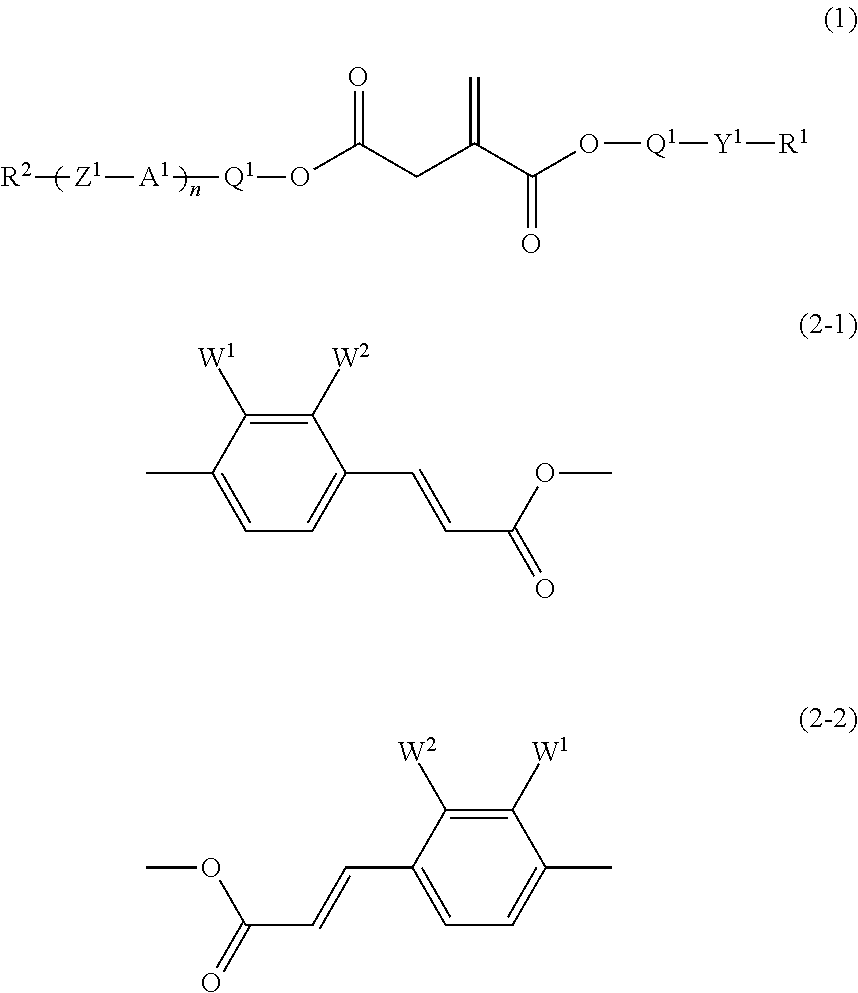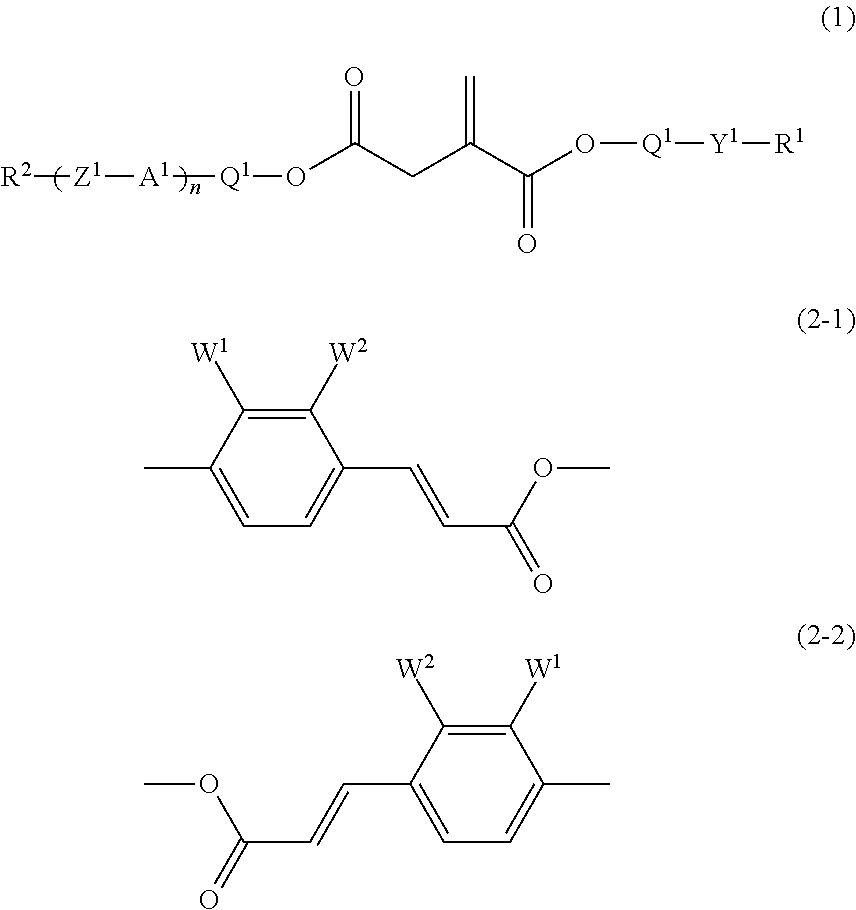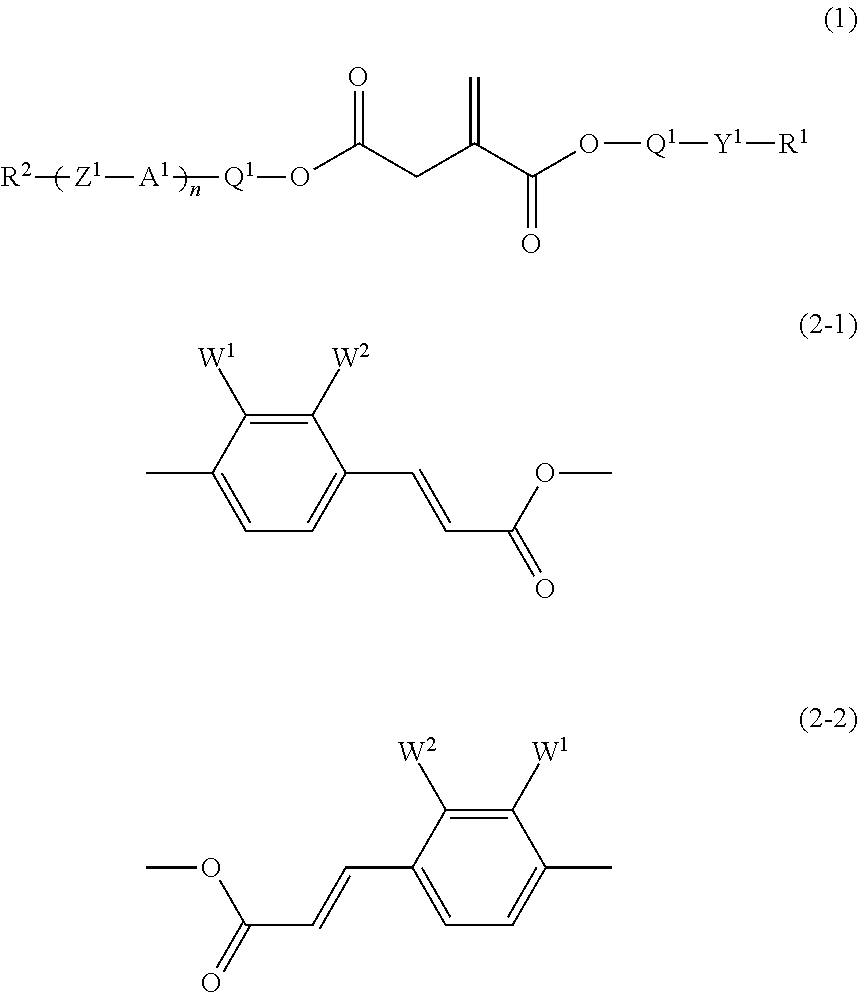Photosensitive compound and its photosensitive polymer
a photosensitive polymer and compound technology, applied in the field of photosensitive compound and its photosensitive polymer, can solve the problems of hardly practical use, decrease in brightness or contrast, etc., and achieve the effects of avoiding deactivation of radicals, uniform molecular distribution, and enhancement of photosensitive polymerization
- Summary
- Abstract
- Description
- Claims
- Application Information
AI Technical Summary
Benefits of technology
Problems solved by technology
Method used
Image
Examples
example 1
[0158]The compound (1-1-4) was prepared in the following way.
First Step:
[0159]trans-Coumaric acid (400 g) was added to methanol (1,200 ml) and concentrated sulfuric acid (10 g) was added dropwise, and the mixture was heated under reflux with stirring for 5 hours. After the reaction mixture had been cooled to room temperature, the methanol was distilled off under reduced pressure. The resulting residue was poured into ice-water (2,000 ml), and the mixture was extracted with ethyl acetate (2,000 ml). The combined organic layers were washed with a saturated aqueous solution of sodium hydrogencarbonate and water, and dried over anhydrous magnesium sulfate. The ethyl acetate was distilled off under reduced pressure, and the resulting residue was recrystallized from ethanol to give the compound (ex-1) (280 g).
Second Step:
[0160]Itaconic acid anhydride (250 g) was added to isopropyl alcohol (150 ml), and the solution was heated at 100° C. with stirring under an atmosphere of nitrogen for 6 ...
example 2
[0165]The compound (1-1-1) was prepared in the following way.
[0166]The compound (ex-1) (31 g), monomethylitaconic acid (25 g) and DMAP (4.2 g) were added to dichloromethane (200 ml), and the mixture was stirred with cooling under an atmosphere of nitrogen. DCC (37.6 g) in dichloromethane (80 ml) was added dropwise. After the addition, the stirring was continued at room temperature for 16 hours. Precipitates were filtered off, and the filtrate was washed with water and dried over anhydrous magnesium sulfate. The dichloromethane was distilled off under reduced pressure and the residue was purified by column chromatography (silica gel, eluent: toluene / ethyl acetate=8 / 1 by volume), and then by recrystallization from methanol to give the compound (1-1-1) (42 g).
[0167]The phase transition temperature and the NMR analysis data of the resulting compound (1-1-1) were as follows.
[0168]Phase transition temperature: C 80 I.
[0169]1H-NMR (CDCl3; δ ppm): 7.69 (d, 1H), 7.55 (d, 2H), 7.17 (d, 2H), 6...
example 3
[0170]The compound (1-1-7) was prepared in the following way.
[0171]The compound (ex-1) (27.4 g), itaconic acid (10 g) and DMAP (3.8 g) were added to dichloromethane (200 ml), and the mixture was stirred with cooling under an atmosphere of nitrogen. DCC (33.3 g) in dichloromethane (70 ml) was added dropwise. After the addition, the stirring was continued at room temperature for 16 hours. Precipitates were filtered off, and the filtrate was washed with water and dried over anhydrous magnesium sulfate. The dichloromethane was distilled off under reduced pressure and the residue was purified by column chromatography (silica gel, eluent: toluene / ethyl acetate=4 / 1 by volume), and then by recrystallization from toluene to give the compound (1-1-7) (7 g).
[0172]The phase transition temperature and the NMR analysis data of the resulting compound (1-1-7) were as follows.
[0173]Phase transition temperature: C 131 I.
[0174]1H-NMR (CDCl3; δ ppm): 7.69 (d, 1H), 7.66 (d, 1H), 7.57 (d, 2H), 7.53 (d, 2...
PUM
| Property | Measurement | Unit |
|---|---|---|
| Molecular weight | aaaaa | aaaaa |
| Photosensitivity | aaaaa | aaaaa |
| Liquid crystal transition temperature | aaaaa | aaaaa |
Abstract
Description
Claims
Application Information
 Login to View More
Login to View More - R&D
- Intellectual Property
- Life Sciences
- Materials
- Tech Scout
- Unparalleled Data Quality
- Higher Quality Content
- 60% Fewer Hallucinations
Browse by: Latest US Patents, China's latest patents, Technical Efficacy Thesaurus, Application Domain, Technology Topic, Popular Technical Reports.
© 2025 PatSnap. All rights reserved.Legal|Privacy policy|Modern Slavery Act Transparency Statement|Sitemap|About US| Contact US: help@patsnap.com



